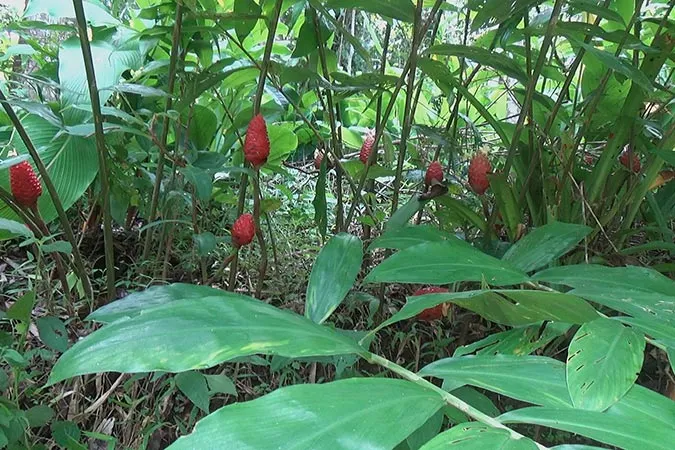Lempuyang or shampoo ginger (Zingiber zerumbet) is a plant species in Zingiberaceae, a spice with leafy stems, grows up to 1.2 m tall, grows wild in the shade, rhizomes are used as food flavoring and appetizers in various dishes, rhizome extract is used in treatment.
Z. zerumbet in the dry season undergoes a period of inactivity on the soil where the leafy stems wither and die, leaving pale brown rhizomes that crawl across the soil surface. The stems will grow back and produce flowers in the rainy season.
Leaves 10-12 fins with pointed tips, 15-20 cm long, grow in alternating arrangements on thin, erect stems to 1.2 m high. Flower heads grow between stems. Flowers are conical, have stick-shaped stalks, erect, separate from the stem and shorter.
The flower heads are green and turn red, 3-10 cm long with overlapping scales, covering the small yellowish white flowers poking out. Mature flowers gradually fill with an aromatic and slimy liquid.
The rhizomes, leaves, petioles and flowers have a fragrant aroma. Often used to enhance the taste of meat and fish when cooked. The rhizomes are sliced, dried, and ground into a powder. The gel on adult flower heads is used to soften and make hair shiny.
Kingdom: Plantae
Phylum: Tracheophyta
Subphylum: Angiospermae
Class: Liliopsida
Order: Zingiberales
Family: Zingiberaceae
Genus: Zingiber
Species: Zingiber zerumbet
Subspecies: Zingiber zerumbet ssp. cochinchinense, Zingiber zerumbet ssp. zerumbet
Z. zerumbet in the dry season undergoes a period of inactivity on the soil where the leafy stems wither and die, leaving pale brown rhizomes that crawl across the soil surface. The stems will grow back and produce flowers in the rainy season.
Leaves 10-12 fins with pointed tips, 15-20 cm long, grow in alternating arrangements on thin, erect stems to 1.2 m high. Flower heads grow between stems. Flowers are conical, have stick-shaped stalks, erect, separate from the stem and shorter.
The flower heads are green and turn red, 3-10 cm long with overlapping scales, covering the small yellowish white flowers poking out. Mature flowers gradually fill with an aromatic and slimy liquid.
The rhizomes, leaves, petioles and flowers have a fragrant aroma. Often used to enhance the taste of meat and fish when cooked. The rhizomes are sliced, dried, and ground into a powder. The gel on adult flower heads is used to soften and make hair shiny.
Kingdom: Plantae
Phylum: Tracheophyta
Subphylum: Angiospermae
Class: Liliopsida
Order: Zingiberales
Family: Zingiberaceae
Genus: Zingiber
Species: Zingiber zerumbet
Subspecies: Zingiber zerumbet ssp. cochinchinense, Zingiber zerumbet ssp. zerumbet
